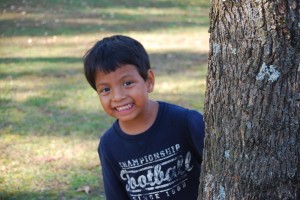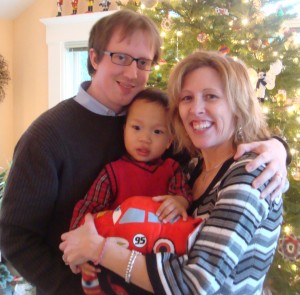 When Patricia Moody adopted Ben from Guatemala in 2005, she had every intention of one day giving her son a little brother or sister. But today, Moody doesn’t see how that will be possible. “It has become much more difficult to adopt internationally,” Moody said, “and I don’t think I could afford it financially.”
When Patricia Moody adopted Ben from Guatemala in 2005, she had every intention of one day giving her son a little brother or sister. But today, Moody doesn’t see how that will be possible. “It has become much more difficult to adopt internationally,” Moody said, “and I don’t think I could afford it financially.”
Moody isn’t the only one backing down from adopting overseas. Americans last year adopted 12 percent fewer children from abroad, according to the U.S. State Department. The reasons are varied – increased red tape, crackdowns on baby trafficking, a slide in the U.S. economy, new regulations and increasing costs.
“With the economy suffering and people losing their jobs, people are not looking to international adoption. Cost is a big thing,” said Debra Wilson, child placing supervisor at Children’s Home Society of Virginia in Richmond.
Adopting from overseas can cost from $25,000 to $40,000, Wilson said. But an even bigger deterrent might be the Hague Convention on Protection of Children, which entered into force for the United States in April, 2008. The Convention is an international agreement to safeguard intercountry adoptions and establishes international standards of practices.
The intent of the Hague Convention is to protect the welfare of children, birth parents, and adoptive parents from the exploitation and corruption sometimes associated with foreign adoptions. Its regulations were put into place to prevent the abduction, sale, or trafficking of children.
It also means more forms, fees and red tape, which lengthens the adoption process. Only a handful of adoption agencies have Hague accreditation, said Rebecca Ricardo, executive director of Coordinators 2, an adoption resource for families in Richmond.
“It’s expensive to get, so agencies that have it pass that cost on to their clients,” she said.
In addition to the Hague Convention, individual countries are imposing more restrictions when it comes to who can adopt. Russia and China, for example, have launched incentives for domestic families to adopt internally. Guatemala has closed its doors completely.
“People who adopt internationally have to have a lot of time, patience and finances,” Ricardo said.
With the most popular countries imposing tougher restrictions, families are seeking alternative countries. Ethiopia, Buildi ng a Global Family Inter national Adopti on by Janet Showalter Patricia Moody had hoped to give her Guatemalan-born son, Ben, a brother or sister, but with new restrictions on international adoptions, the single mom is not sure that can happen. For example, last year had the biggest increase of American placements (from 1,255 to 1,725).
“China is a different place now,” said Tracey Malkie. She and her husband, Scott, adopted their first child, Van, from China in 2008. “It is so much tougher, and the wait would be forever.”
This time around, the Malkies have turned to the Democratic Republic of the Congo, where they hope to adopt another son. Instead of a two-year wait or longer – like the one they would expect should they go through China again – the Malkies hope to bring home their second child in a few months.
Other couples have recently looked into the possibility of adopting from Haiti in response to the devastating earthquake there. But according to the Joint Council on International Children’s Services, applications for new adoptions have been closed to protect Haitian children from illegal adoptions, abduction and child trafficking.
The Haitian and U.S. governments have, however, expedited the adoption of children already matched to adoptive parents.
“We have been receiving a few inquiries a week,” Wilson said. “If people could, they would bring these children home today. But that is not how it works.”
That means prospective parents interested in adopting from Haiti will have to be patient and hope the application process will reopen soon. Last year, Haiti recorded 330 adoptions.
For Moody, the adoption process for her son began in January, 2005. She brought Ben home seven months later. But under today’s tighter restrictions, she would have a much more difficult time adopting because she is single.
“I think it’s terrible that they make the process so difficult and so expensive,” Moody said. “These are children we are talking about. It seems they are taking advantage of families who desperately want nothing more than to love a child.” The peak year for intercountry adoptions by Americans was 2004, with 22,884. Last year, the number fell by more than 5,000 to 17,438 – down from 19,613 the year before. That total is the lowest since 1999.
“Ten years ago, we were receiving five or six new inquiries a month from people wanting to adopt internationally,” Wilson said. “Now, we maybe receive one a month. And some of our parents who have completed their home studies have been waiting years. I’m not sure that is going to get any better.”
Still, some U.S. families prefer the international route. Adopting domestically, they say, is even more daunting.
“It’s such a personal choice,” Tracey Malkie said. “For us, we felt adopting domestically was too unpredictable – the birth mother might change her mind or would want money. And you don’t know what you could be opening yourself up to later on.”
But those Lifetime Channel movies that depict a deranged birth mother seeking custody of her child 10 years after giving birth don’t play out in the real world, Wilson said.
“Still, with the Internet and Facebook, people get nervous about birth mothers tracking them down years later,” she said. “So for some, international adoption is a good choice.”
Just not an easy one.
“We will all have to be patient to see if things will change,” Ricardo said. “Maybe some of these countries will reopen their doors. We’ll just have to wait and see.”
That doesn’t bode well for couples and singles wanting nothing more than a child of their own.
“Sometimes I feel like it’s never going to happen,” said Rochelle Garwood, hoping to adopt from China. “It’s gotten a little crazy.”
Garwood and her husband, Bob, have been waiting since 2006 for a placement. When they filed their paperwork three years ago, they were told the wait would be about a year. Recently, though, their international agency told them it could be as long as 2012 for a healthy infant. So the Garwoods filed paperwork stating they would accept some special needs, including cosmetic disabilities.
“Now, we are hoping within the next few months we might hear something,” Rochelle Garwood said. “In the end, we know it will be worth the wait.”
Having a child, adoptive parents say, will change your life.
“Suddenly, you see the world in terms of your child,” Tracey Malkie said. “No longer is it, ‘What do I need?’ It’s all about him. There’s nothing I wouldn’t do for our son.”
That awesome responsibility, Malkie said, makes all the red tape well worth fighting through.
“When we met Van for the first time, we knew we had done the right thing,” she said. “The process may not be easy, but that’s no excuse. When we saw how these kids were living in orphanages and how poor they were, we couldn’t imagine not doing it. It’s the best decision we’ve ever made.”



